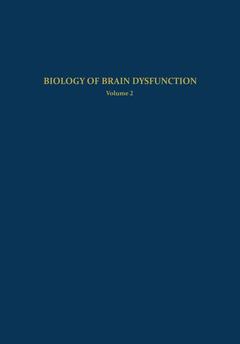Biology of Brain Dysfunction, 1973 Volume 2
Langue : Anglais
Auteur : Gaull Gerald E.

The growth of neurochemistry, molecular biology, and biochemical genetics has led to a burgeoning of new information relevant to the pathogenesis of brain dysfunction. This explosion of exciting new information is crying out for collation and meaningful synthesis. In its totality, it defies systematic summa tion, and, of course, no one author can cope. Thus invitations for contributions were given to various experts in areas which are under active investigation, of current neurological interest, and pregnant. Although this project is relatively comprehensive, by dint of size, other topics might have been included; the selection was solely my responsibility. I believe systematic summation a virtual impossibility-indeed, hardly worth the effort. The attempt to assemble all of the sections involved in a large treatise with mUltiple authors inevitably results in untoward delays due to the difference in the rate at which various authors work. Therefore, the following strategy has been adopted: multiple small volumes and a relatively flexible format, with publication in order of receipt and as soon as enough chapters are assembled to make publication practical and economical. In this way, the time lag between the ideas and their emergence in print is the shortest.
1 Disorders of Sphingolipid Metabolism.- I. Introduction.- II. Chemistry, Metabolism, and Distribution of Sphingolipids.- III. Individual Sphingolipidoses.- IV. Summary and Concluding Remarks.- References.- 2 Disorders of the Cerebral Circulation.- I. Introduction.- II. Methods for Study of the Cerebral Circulation.- III. Regulation of the Cerebral Circulation.- IV. Dysfunction of Regulatory Mechanisms.- V. Intravascular Phenomena.- VI. Secondary Effects of Disturbed Regulation.- VII. Conclusion.- References.- 3 Effects of Narcotic Analgesics on Brain function.- I. Introduction.- II. Physiological Effects of Narcotic Analgesics.- III. Metabolism of Narcotic Analgesics in the Nervous System.- IV. Biochemical Responses to Narcotics.- V. Electroencephalography.- VI. Theories on the Mechanism of Addiction to Narcotics.- VII. Summary and Conclusions.- References.- 4 Genetic Disorders of Brain Development: Animal Models.- I. Introduction.- II. Chromosomal Organization in Eukaryotes.- III. Development of the CNS.- IV. Genetic Disorders of Brain Development.- V. Prevention of Brain Dysfunction.- References.- 5 Experimental Allergic Encephalomyelitis.- I. Introduction.- II. Historical Background.- III. Identification of Specific Encephalitogenic Components of CNS Tissue.- IV. Pathogenesis of EAE.- V. Possible Relationship of EAE to Human Demyelinative Disorders.- Acknowledgments.- References.- 6 Disorders of Fatty Acids.- I. Introduction.- II. Fatty Acids in Normal Brain and Nerve.- III. Phytanic Acid Storage Disease (Refsum’s Disease).- IV. Disorders with Storage of Ceroid.- V. Other Storage Disorders.- VI. Demyelination of Known Etiology.- VII. Multiple Sclerosis.- VIII. Other Human Disorders.- IX. Animal Disorders.- X. Criteria for Establishing Primary Disorders of CerebralFatty Acid Metabolism.- References.- 7 Bilirubin Encephalopathy.- I. Introduction and Historical Perspective.- II. Chemistry and Metabolism of Bilirubin with Special Note of Variations Seen in the Newborn Period.- III. Protein Binding of Bilirubin.- IV. Problems Hampering Research.- V. Pathological Lesion of Bilirubin Encephalopathy.- VI. Extraneural Pathological Lesions Induced by Bilirubin.- VII. Metabolic Lesions Induced by Bilirubin.- VIII. Why Is Brain Damage the Main Pathological Phenomenon Induced by Bilirubin?.- References.- 8 The Action of Thyroid Hormones and Their Influence on Brain Development and function.- I. Introduction.- II. General Role of Thyroid Hormones in the Structural and Functional Maturation of the Nervous System.- III. Biochemical and Metabolic Effects of Thyroid Hormones in Nervous Tissues.- References.- 9 Biology of the Striatum.- I. Introduction.- II. Role of the Striatum in Motility.- III. Role of the Striatum in Mental Function.- IV. Role of the Striatum in Autonomic Functions.- V. Conclusions.- References.- 10 Pathophysiology of Central Nervous System Regulation of Anterior Pituitary function.- I. Introduction.- II. Concept of Endocrine Regulation Via Releasing Hormones of Neural Origin.- III. Factors Involved in the Periodic Release of Pituitary Hormones.- IV. Effect of Neonatal Hormonal Milieu on Neuroendocrine Control Mechanisms.- V. Clinical Correlates.- References.- of Volume 1.- Articles Planned for Future Volumes.
Date de parution : 03-2012
Ouvrage de 422 p.
17.8x25.4 cm
Thème de Biology of Brain Dysfunction :
Mots-clés :
biology; brain; growth; information; molecular biology; physiology
© 2024 LAVOISIER S.A.S.



